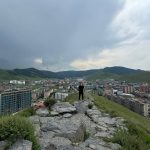THE NIGERIAN SERIES, DAY 1-3
LAGOS
The World’s Biggest Floating Slum. After treating myself to a few trips in Asia recently, I knew I was delaying the evitable… getting back to Africa.
WELCOME TO COUNTRY NUMBER 173
“I love Africa — the more I see of it, the more I enjoy it. But it’s a b*llocks to record, obtain visas and get around.”
ARRIVAL
I landed in Lagos expecting the worst at immigration. I had heard too many horror stories — tales of bribery, endless “anything for me” requests, and aggressive customs officers.
But what I got instead was very different; smiles and a warm welcome. Maybe Nigeria decided to surprise me early.
The World’s Biggest Floating Slum
DAY 3: MAKOKO — THE FLOATING SLUM
Today, we finally got moving. First stop: Makoko, often called the world’s largest floating slum. Every building — school, clinic, home, church — is built on wooden stilts stretching out into the dark and dirty waters of the Lagos Lagoon. It might be a city on water, but without the glamour.
The World’s Biggest Floating Slum
CHARITY WORK
Our guide today was Sunday, the son of the community chief. He took me to the community’s pièce de résistance, a local school and orphanage built with the help of a YouTuber and a world traveller. Makoko may be a slum, but the sense of self-reliance here is massive. The government doesn’t recognise the settlement officially — offering no support — so the people have turned to each other, and to outside sponsors, to survive.
The World’s Biggest Floating Slum
RELATED READ: DRONE ISSUES AND AFRICA’S BIGGEST URBAN SLUM
INSIDE A LOCAL’S HOME
To get a true sense of life here we were invited into a local home. One room, about the size of a garden shed, sleeps six people. A stove by the door acts as the kitchen and a bucket in the corner is the shower. The floor, made of battered wood planks, is so full of gaps and holes that dropping anything basically means donating it to the lagoon gods below. How anyone gets a full night’s sleep here is beyond me.
MAKOKO FACTS:
- Makoko is often called the “Venice of Africa,” but most homes lack running water and electricity.
- The community is estimated to house over 200,000 people, though exact numbers are unknown due to lack of government census.
- The original settlement dates back to the 18th century, established by fishermen from the Egun ethnic group.
ISSUES WITH THE GOVERNMENT
The government has made several attempts to halt Makoko’s expansion — and not politely. In the past, they demolished parts of the settlement before public backlash slowed them down. However those challenges haven’t disappeared.
More recently, a new sandbar has mysteriously appeared at the edge of the community. Officially, no one has confirmed what it’s for. But the locals here believe it’s meant to block any further growth.
SELF-SUFFICENT
With no outside support the community is almost entirely self-sufficient. There’s a local bar which can get lively at night, small businesses, restaurants but no rubbish collection system. Every bit of waste and sewage ends up directly in the water, giving off a powerful stench that’s impossible to ignore.
With very little space for kids to play, they are often found jumping in and out of the water, something that would cause all sorts of health issues for the rest of us. But just like the community itself, kids have found a resilience to what would otherwise be a health risk for others.
TODAY’S YOUTUBE VIDEOS
If you want to see today from a different perspective, and catch a few different stories from the front row, then check out today’s YouTube video below.
FINAL THOUGHTS
Against all odds, the people here have built a life where the government continue to fail them.
SAFE TRAVELS, DS x
173/229
NEXT UP
Heading to the hometown of Boko Haram!! Click to read.
This post is episode 1 of the Nigerian Series, for the entire series click here.
To see a different side of my trip head to my social channels; YouTube, Instagram & TikTok. Links at top of the page.

Question Time
- Would you dare to visit Makoko?
- Should governments offer more support to informal communities like this?
- How do you think life on a floating slum would change your perspective?
Let me know in the comments below . . .




























